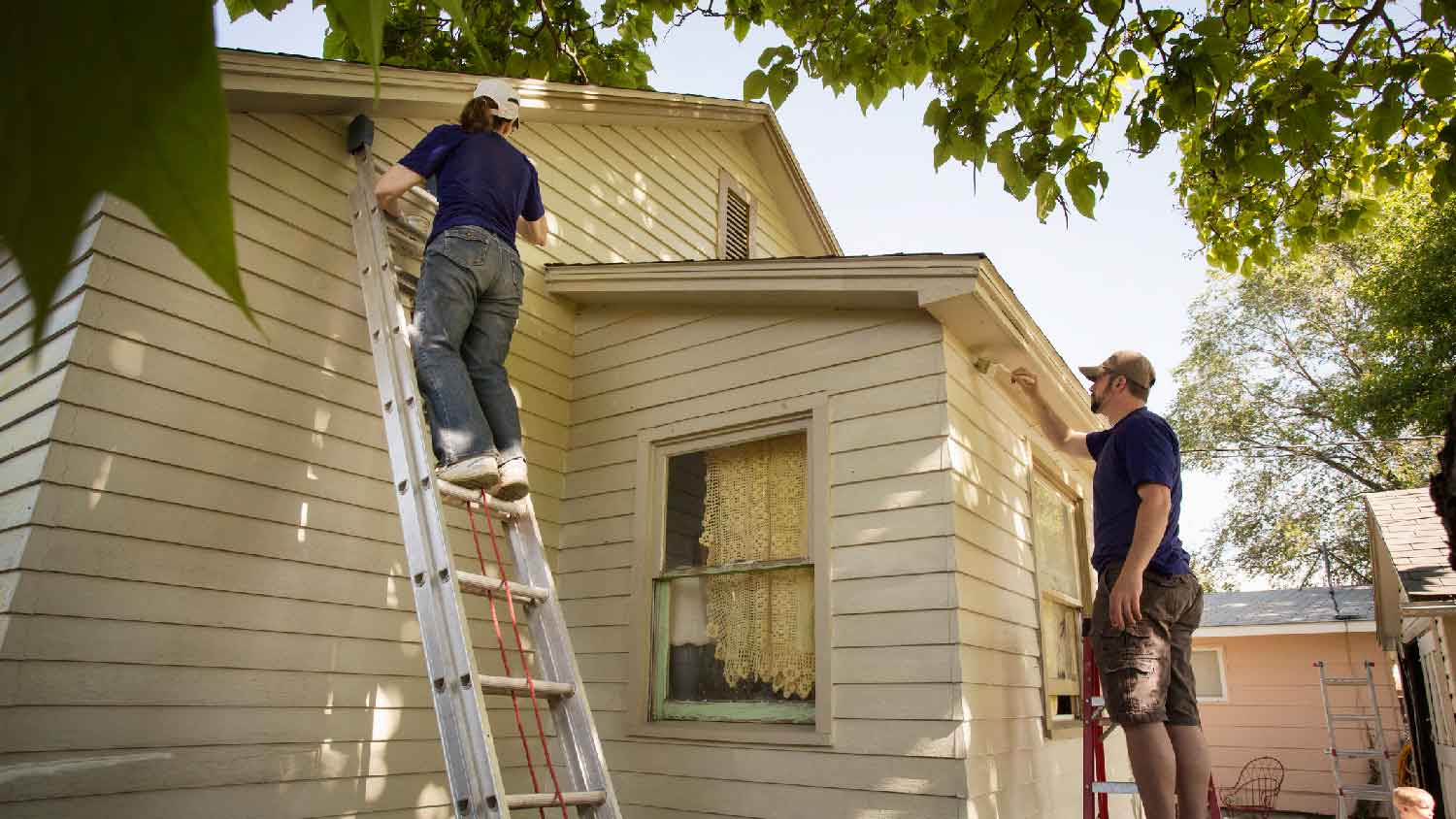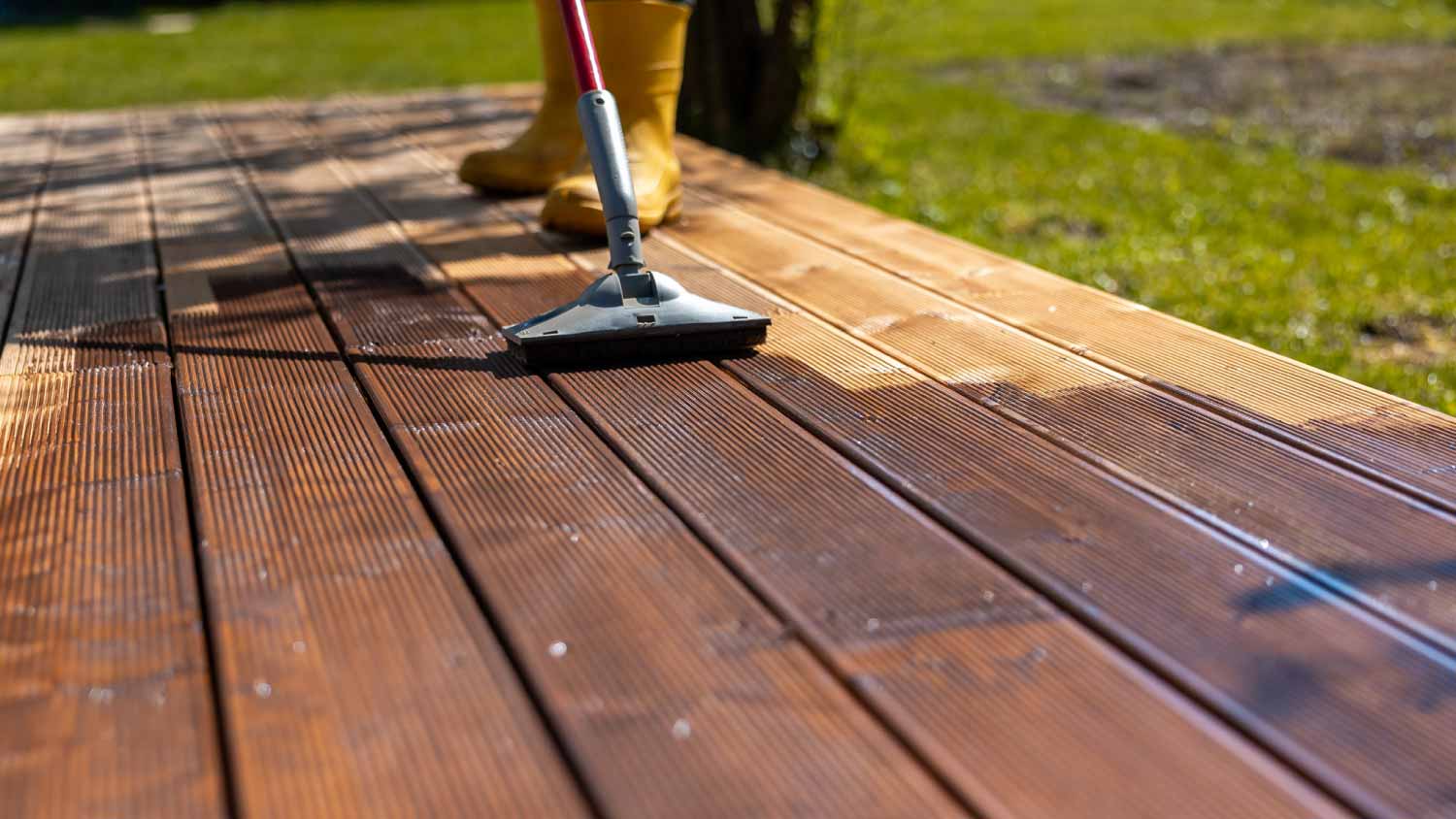
The cost to paint a stucco house depends on its size, the type of paint used, and any required repairs. This guide will help you budget for the painting project.
Give your abode what it needs to shine from the outside in


Exterior paint can last anywhere from three to 20 years, depending on siding material.
Everything from local climate to paint quality can affect its lifespan.
Signs your home exterior needs to be painted include fading, cracking, bubbling, and peeling.
A well-painted house signals to both you and the world that your home is a happy place to be. Like anything, though, it’ll need an occasional revamp to continue looking its best for the long haul.
As for how often to paint a house exterior, that will depend on how well it was painted the first time around, your home’s siding type, and the local climate. Find out when you should plan your next exterior painting project.
"I usually recommend exterior home painting in spring and fall since temperatures outside can impact how well your paint adheres and how long that exterior paint job lasts. I don’t recommend painting when there’s any risk of below-freezing temperatures or when it’s above 80 degrees or higher. The sweet spot is right around 60 degrees or so for paint that dries thoroughly and has good adhesion."
— Carr Lanphier, CEO at Improovy, Wayne, New Jersey

Everything from your local climate to whether you have wood, brick, or aluminum siding affects how long exterior paint lasts.
Siding can be made from various materials, and all have different life expectancies when it comes to paint jobs.
Wood siding is more vulnerable to water damage which can result in paint bubbling or cracking, so it needs updating every three to seven years.
Aluminum siding is slightly more durable, allowing it to last around five years.
Both stucco and vinyl, which are similarly long-lasting, will start to falter around the 10-year mark.
Finally, painted brick has the best potential lifespan—between 15 and 20 years—but that’s provided the paint was properly applied.
The only way an exterior paint job can meet its max life expectancy is if it was properly completed in the first place. Shoddy work or forgetting to apply necessary finish coats and protective treatments can prematurely lead to wear and tear, such as cracking, bubbling, and fading.
If your siding has a moldy spot, a crack or hole, or anything similar, it can cause your paint job to wear away faster than it normally should. When in doubt, make any and all necessary repairs before applying a fresh coat so the same thing doesn’t happen again.
The more duress your siding is under, the more likely the paint on it will expire faster. Being exposed to extreme weather won’t hurt once or twice, but months of snowfall and heavy rainy seasons every year will lead to faster cracking, fading, bubbling, and the like over time.
Opting for a low-quality exterior house paint may save you a bit of money upfront, but it’ll end up costing you when need to apply a fresh coat sooner. That doesn’t mean you have to swing for the most expensive option. There are plenty of moderately priced alternatives that will do the job and prove their staying power.
In that same vein, make sure you’re choosing the right kind of paint for the material your siding is made from. For instance, the best paint for aluminum might be totally different from the ideal choice for wood. Additionally, keep in mind that lighter colors don’t fade as quickly as dark ones, and consider opting for the former if you live somewhere that experiences non-stop sunlight.
Painting a house exterior is no small feat. First, you have to acquire all the right tools and equipment—which can be different from what you’d use for interior painting. Then you have to apply multiple coats of paint, plus a finish, and sometimes additional protective layers or varnishing. If you’re tired from just reading all that, hiring an exterior painter near you will ensure the job is done well, and you won’t have to lift a finger.
Here are all the clues that your house exterior is begging for a refresh.
Even the best exterior house paints will begin to fade after extended sun exposure. If the color of your home is suddenly completely different than it once was, that means it’s time to whip out a brush and a can of paint.
Cracking in paint or caulk is most likely to occur in materials that are sensitive to water, like wood or stucco siding. A little cracking here or there is no cause for concern, but if you notice it all over your home, it may be time to add a fresh coat.
Exterior paints are formulated to withstand shrinking and expanding from temperature fluctuations, but even they have their limit. Over time, the paint in place, especially on wood or aluminum siding, may begin to cave in on itself giving the appearance of shrinking, and you’ll know it’s time to treat it when this issue becomes widespread.
Staining results from water damage or mold and mildew. Not only is this a major sign that you need to freshen up the exterior paint, but it may also indicate a large issue that needs to be repaired.
Powdering only occurs on brick walls and happens when an underlying moisture issue causes the salt from within to form a white, flour-like residue on your home exterior. It’s a sign you need to repaint, but also an indication that you may have larger water damage that needs to be dealt with.
Bubbling paint and peeling can happen on all kinds of walls and stems from a whole host of possible factors, from moisture to high temps. Most importantly though, it means your current coat of paint has run its course and is in need of a refresh ASAP.
From average costs to expert advice, get all the answers you need to get your job done.

The cost to paint a stucco house depends on its size, the type of paint used, and any required repairs. This guide will help you budget for the painting project.

The cost to paint a deck depends on its size, design, and whether you DIY. Read this guide to help set the budget for your deck painting project.

The cost to paint a pool deck depends on the dimensions and material, the type of paint, and whether you DIY. Read on to help determine a project budget.

How much stain do I need for my deck? It’s one of the most important parts of any deck revival project. Here’s how to calculate what you need.

Breathe new life into your deck by sanding it before adding stain. Follow this guide to learn how to sand a deck and choose the right grit sandpaper.

What is the best type of paint for exterior homes? Keep reading to narrow down your paint options once and for all.